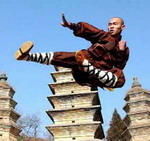|

Part 2
The training chambers of Shaolin have assumed a nearly mythical status among martial artists, probably because of the legendary results of their successful students. In reality, the chambers were simply training areas for different aspects of kung fu.
Some were style-specific, that is, where you would learn the kuen (formwork) of tiger or dragon. Others were places for muscular development, such as horse-training and water-carrying chambers.
Some taught coordination and reflex drills; combat and sparring; weapons use; and meditation and visualization techniques. The actual number of chambers varied, depending upon which temple you were in, the combination of skills taught as a "core" by particular training masters, and, naturally, the size of the temple. You might study a crane form in chamber 4 at 8 a.m., practice sparring there at 12, and return for coordination drills at 5.
Part 3
It is important to stress that more myth surrounds our general beliefs about Shaolin monks than is warranted. Among the readily dismissed fallacies are: Shaolin were all male, were celibate, were primarily warriors, studied primarily kung fu, were all trained physicians, were different somehow from other people. Myths place real people on pedestals, and this does nothing for potential students. After all, who could possibly and realistically expect to attain demi-godhood? Shaolin had their heroes and villains, ascetic priests and political rebels, devout celibates and prolific parents.
The most universally held belief seems to be that Shaolin was a place to study, first and foremost, kung fu. China has a history of hundreds of martial arts, only a small fraction being true "Shaolin" practices, so it was virtually never necessary to get thee to a convent to learn pugilism.
In fact, the combat side of Shaolin Kungfu was taught to Shaolin disciples as a means of combating the self, to restrain ego and develop physical domain over your own body. Consider how little true control people generally have over themselves; we are never far from a "pathological" klutz, or people who revv their physical energies to little avail.
When Bodhidharma instituted the practices that evolved into kung fu, his primary concern was to make the monks physically strong enough to withstand both the isolated lifestyle and the deceptively demanding training that meditation would require. In fact, it is one of the oldest Shaolin axioms that "one who engages in combat has already lost the battle." Such philosophies, alas, make for terrible movie plots...
The early phases of training in Shaolin Temple involved a lot of what we would call grammar school (for most students, entry was made when under the age of ten). Long days were spent learning to read and write, and quality calligraphy was seen as proof of a good education. Students also learned math, history, manners and customs, Taoist and Buddhist philosophies, painting, music, textile work, agriculture, pottery, and cooking.
To be anything less than self-sufficient was seen as a failing of the training regimen. Older students and disciples would often write books of history, poetry, or natural history, while others would form musical ensembles (often with a master or two), paint, or learn medicine. It was one's development of the cultural side of life that mainly marked one's standing in the Shaolin community.
Hence the rather large amount of building space for housing a library, art materials, a music area, and other life-skills. Such interests were actively encouraged, and to again draw a parallel to modern American universities, such monks often taught "outreach" sessions to the local community. Wandering monks brought art, reading, medicine, and agriculture to remote villages, while people near a temple could come for sessions in all these topics. Mainly, however, they came for farming and medical assistance, as most Chinese villagers were not as intellectually active as some "New Agers" would have us believe.
Now for a controversial note: our instructors, all products of the old temples, taught that if a person study Shaolin and learn little more than kung fu, he was not Shaolin. All the arts of the temple were aimed at leading one closer to enlightenment by providing tools to make a whole person, or what we often call Renaissance people. A jack of many trades, master of one or two, those are qualities that define a priest, according to those who long made such designations in China. If you are a young person in school, do not sacrifice studies for martial arts; even if you learn skill, a tool with a dull edge is a dull tool of limited use.
Day One Day Two
 China Tours inclusive of visiting the Shaolin Temple, Mount Songshan China Tours inclusive of visiting the Shaolin Temple, Mount Songshan
|
|